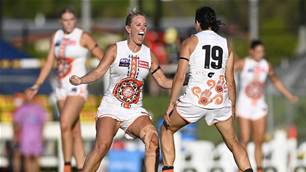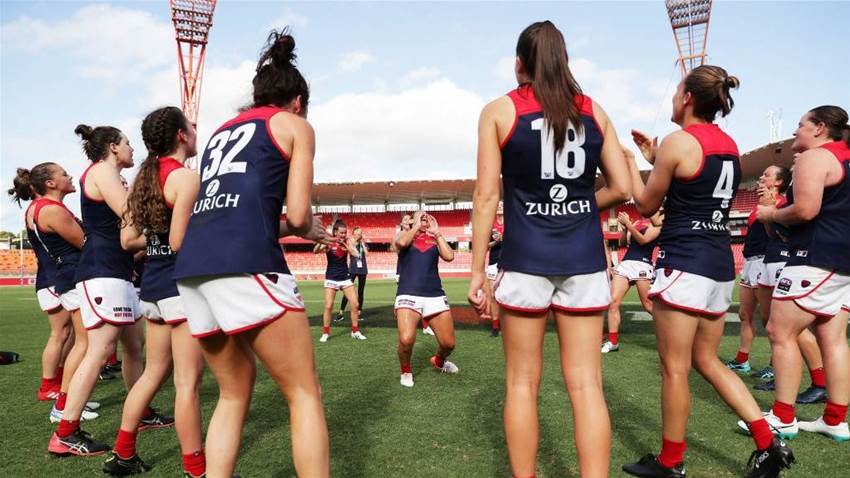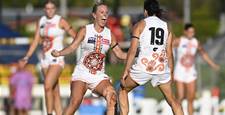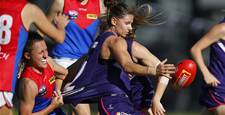A problem has been looming for the Melbourne Demons and it's only stalked its way closer through the 2020 trade period.
The struggle to develop young players into senior talent is threatening to eat Mick Stinear’s list from the bottom up.
Over four seasons, Melbourne has signed 16 players aged 18-20 through draft, trade or free agency.
The six players to have graduated to the first 21 on a consistent basis are Katherine Smith, Aliesha Newman, Lily Mithen, current North Melbourne player Jasmine Grierson (all 2016 draftees/rookie signings), Eden Zanker (2017 draft) and Tyla Hanks (2018 draft). Now, the ultra-reliable defender Smith and sparkplug small forward Newman will depart Gosch’s Paddock to GWS and Collingwood respectively.
The output of the remaining 10 players has been modest at best. 2016 second-round draft pick Deanna Berry was traded to the Bulldogs after one season where her career has stalled. Other players from the inaugural draft include Jess Anderson (also a one-year player destined for the Bulldogs) and the luckless Ainslie Kemp, who suffered two ACL injuries in four seasons before sadly being delisted just last week.
The 2017 draft yielded even fewer rewards. Maddy Guerin, Claudia Whitfort and Maddie Shevlin failed to forge regular places in the red and blue and have all since found new homes. It would be unfair to the following two years’ worth of draft picks and young rookies to damn or praise just yet but Tyla Hanks (14 games) is the only player of the six to average more than three games a season.
The Demons are hardly Robinson Crusoe with the modest conversion rate of their youth. The Under 18s representative pathway to the women’s national competition is building in strength and productivity year by year but still in its infancy compared to the men’s programs. Moreover, the rapid expansion of the competition from eight clubs to 14 over four seasons has seen clubs develop a reliance on mature-age players and cross-coders with the physique to withstand the pace and intensity of AFL Women’s.
List structure problems often do not reveal themselves ahead of schedule. In the case of the Demons, there has not been any on-field reason for the alarm bells to ring over the last four years.
Melbourne’s competitiveness can be attributed to the signing of outstanding foundation players and leaders, the canny eye of list managers Todd Patterson and Anthony De Jong in securing talent from unlikely places and excellent squad stability (12 of the Demons’ original 30 players were still at Gosch’s Paddock in 2020, putting Mick Stinear’s side first for player retention).
However, if there is anything we have learned in AFL Women’s, it is that teams’ fortunes can turn quickly. It’s a whirling merry-go-round running on competition expansion, the incentives of increasing wages and players balancing football with work and/or study that has only partly slowed with the introduction of two-year contracts in March last year.
Todd Patterson spoke to melbournefc.com.au prior to the trade period and spoke of the prioritisation of “add[ing] further young talent” to Melbourne’s squad to “give us a chance to build on our list moving forward”. Losing Smith and Newman has not helped this aim while O’Dea moving to Carlton, big-game hunter key defender Harriet Cordner to Richmond and Bianca Jakobsson to St Kilda has dented their experience further.
Whilst Melbourne has thus far shown an ability to adapt to the constantly changing landscape, the 2020 draft now presents itself as crucial for the Demons. A hand of picks five, 15, 17, 35, 41 and a fourth-round selection from Geelong leaves the ball in Melbourne’s court: it is not simply a matter of securing good youth. The Demons need to turn the kids of today into the senior stars of tomorrow.
Related Articles

Updated: AFLW Round 2 preview and schedule

AFLW full team rosters for 2022 season













